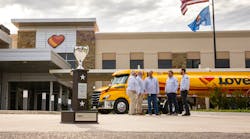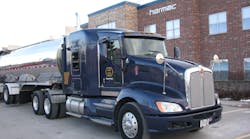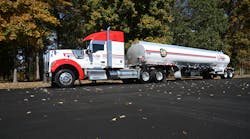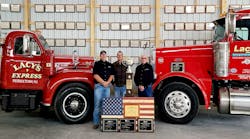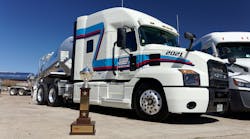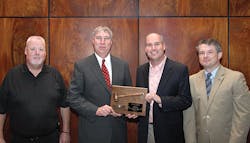UNDER the Obama Administration, the Occupational Safety and Health Administration (OSHA) has moved from its traditional role of compliance assistance—trying to help businesses keep their workplace safe without citation—to aggressive enforcement, with increased inspections, fines, citations, and litigation, according to J Wilson Eaton, an attorney for Burr & Forman.
In his presentation, “OSHA Update 2013: New Twists on Hazard Communication, Recordkeeping, and Confined Space Entry,” Eaton said that the OSHA budget has been increased in the Obama Administration era until this year, when it was $563 million. That includes increases in whistleblower enforcement but decreases in compliance assistance programs. Eaton spoke during the National Tank Truck Carriers’ Tank Cleaning & Environmental Council Meeting held June 3 and 4 in Denver, Colorado.
The most cited standards in fiscal year 2012, in order of focus, were: fall protection, construction (29 CFR 1926.501); hazard communication, general industry (29 CFR 1910.1200); scaffolding, general requirements, construction (29 CFR 1926.451); respiratory protection, general industry (29 CFR 1910.134); control of hazardous energy (lockout/tagout), general industry (29 CFR 1910.147); control of hazardous energy (lockout/tagout), general industry (29 CFR 1910.147); powered industrial trucks, general industry (29 CFR 1910.178); electrical, wiring methods, components and equipment, general industry (29 CFR 1910.305); ladders, construction (29 CFR 1926.1053); machines, general requirements, general industry (29 CFR 1910.212); electrical systems design, general requirements, general industry (29 CFR 1910.303).
“OSHA has fall protection on its mind,” he said.
Hazard communication
He said new rules for hazard communication are designed to align the United States standards with the Globally Harmonized System of Classification and Labeling of Chemicals (GHS). It’s an issue of right-to-know versus right-to-understand.
More fines page 2...
According to the OSHA fact sheet, “The old standard allowed chemical manufacturers and importers to convey hazard information on labels and material safety data sheets in whatever format they chose. The modified standard provides a single set of harmonized criteria for classifying chemicals according to their health and physical hazards and specifies hazard communication elements for labeling and safety data sheets.”
Major changes include:
• Hazard classification. The new standard provides specific criteria to address health and physical hazards as well as classification of chemical mixtures.
• Labels. Chemical manufacturers and importers must provide a label that includes a signal word, pictogram, hazard statement, and precautionary statement for each hazard class and category.
• Safety data sheets. The new format requires 16 specific sections, ensuring consistency in presentation of important protection information.
• Information and training. To facilitate understanding of the new system, the new standard requires that workers be trained by December 1, 2013, on the new label elements and safety data sheet format, in addition to the current training requirements, with full compliance to the final rule in mandated in 2015.
Training involves:
• Label Elements. This includes: product identifier (chemical name, code number, etc); meaning of signal word (“Danger” and “Warning”); pictogram (OSHA requirements; eight OSHA-designated); hazard statement (nature of hazard and, where appropriate, the degree of hazard); precautionary statements (recommended measures that should be taken to minimize or prevent adverse effects resulting from exposure to hazardous chemical or improper storage or handling); name, address, and phone number of chemical manufacturer, distributor, or importer; how an employee might use labels in the workplace (proper storage, first aid, etc).
• Format of new safety data sheets (SDSs). This includes: explanation of the 16-section format; and how the information on the label is related to the SDS.
Confined Space
The confined space standard applies to: general industry employers (ie, not construction, maritime, or agriculture), including most employers in the tank wash industry, if the employer has employees who work in confined spaces.
Confined space is a space that: is large enough and configured so that an employee can bodily enter and perform assigned work; has limited or restricted means for entry or exit; and is not designed for continuous occupancy.
More fines page 3...
The permit-required confined space is “one that contains or has a potential to contain one or more of the following hazards: a hazardous atmosphere; engulfment (eg, grain silos); entrapment or asphyxiation due to configuration; or any other recognized serious safety or health hazard.
“The relevance is that truck tanks can be permit-required confined spaces,” he said. “Truck tanks are large enough for employees to enter and perform work, have limited means of ingress and egress, and are not designed for continuous occupancy. Truck tanks can be permit-required confined spaces if they have the potential to contain a hazardous atmosphere or perhaps other hazards (eg, corrosives).”
As tanks are certainly confined spaces, an employer with a tank wash facility must do the following:
• Determine if the tanks are permit-required confined spaces. This is accomplished by ascertaining what was in the tank or could be in the tank, and by testing the atmosphere. Prior to wash, most tanks should be considered permit spaces.
• Posted against entry. A permit-required confined space must be posted against entry.
• Written program. If a permit-required confined space is to be entered, the employer must devise a written program that details how the space will be entered. The program must include the following: measures to prevent unauthorized entry; how hazards will be identified and evaluated before entry; the procedure to be followed for safe entry; the conditions necessary for safe entry; the opportunity for instruments to monitor pre-entry; the isolation of the space; the means to eliminate or reduce the hazard; the means for determining when entry is proper and the means to ensure that conditions remain proper throughout; testing equipment needed to do monitoring; ventilation necessary for entry; communication equipment; PPE if engineering controls do not work; lighting equipment; ladders for ingress and egress; procedure for reevaluation, if necessary; designated supervision; procedure for completing entry permits; procedure for concluding entry and canceling permit; procedure to review entry if there is a reason to believe that conditions change; periodic review of the program against cancelled permits to ensure compliance.
More fines page 4...
• A permit system. It must document pre-entry measures; have a supervision signature; available permit; duration limit for time needed to do the work; cancellation of permit upon completion or condition change; and permit retention for one year.
• Specific permit information.
• Training. Each affected employee must be trained and establish proficiency in the regulation’s requirements before their initial entry. They must be retrained if conditions change or if their duties change.
• Duties. The regulation specifies the duties of the entrant, the attendant, and the supervisor.
• Rescue and emergency services. The regulation specifies employer duties concerning the selection of a rescue service and the training of employees in rescue.
• Employee participation. The regulation imposes specific rules respecting employee participation.
He said the confined spaces standard applies to tank-wash facilities because unwashed tanks are permit-required confined spaces.
There are certain requirements that must be met: program (a tank-wash facility should have a written program); posting (tank entry rules should be posted); training (the employer should train its employees in the requirements of the standard); testing (tanks should be tested prior to entry); entry procedures (prior to entry, employers must assure that employees have complied with testing, permitting, attendant, harness and retrieval, warning systems, and PPE regulations); and recordkeeping (keep permits for a year).
Ventilation exception
An exception is Subpart (c)(5), which deals with continuous forced air ventilation.
These confined space procedures are different if an employer can: establish that the only hazard is atmospheric; establish by testing that continuous ventilation eliminates the hazard; and ensure that hazards are resolved before the cover is removed.
“In most instances, the only potential hazard in a washed tank is atmospheric,” Eaton said. “Hence, if the employer ensures that this hazard is removed prior to entry through continuous forced air ventilation, the employer need only ensure that the atmosphere is tested, prior to and during entry; employees are trained; monitoring and inspection data is maintained; and employee participation requirements are met.”
He said the exception is Subpart (c)(7), which deals with reclassification. In the case of (c)(7), a tank-truck employer can establish that a washed tank is no longer a permit-required confined space by: establishing through testing that all actual or potential atmospheric hazards are eliminated; establishing that all other hazards have been eliminated. ♦


